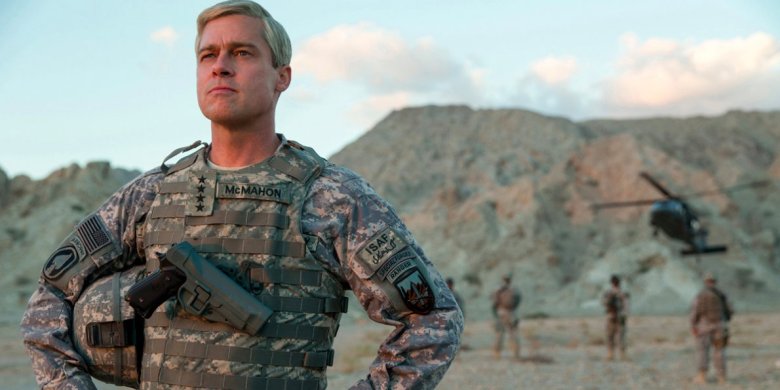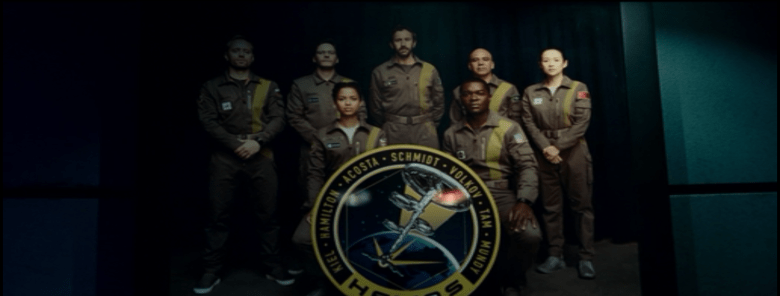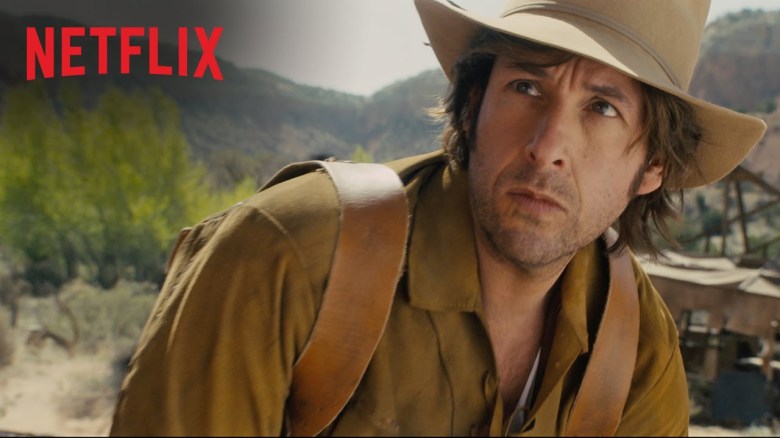Video stores don’t exist anymore, at least not in any real, meaningful way, but the legacy of the straight-to-video movies which used to line their shelves lives on. Regrettable VHS cheapies like Grid Runners (a Lawnmower Man rip-off) and Back to Even (a Lorenzo Lamas stinker) used to entice us with glossy covers and attention-grabbing titles, but we knew that to rent something which didn’t even play in theaters was to risk throwing your money away. Sometimes, that paid off; most of the time, though, you were stuck watching Sometimes They Come Back…Again.
Such movies still get made. Just browse VOD outlets like Vudu for proof of that. However, now Netflix is making (or acquiring) them, too, forging ahead with a dual identity as both the home of trailblazing TV and dumping ground for a lot of schlocky movies. As a result, that “Netflix Original” label is starting to carry two different meanings, but we’re still operating under the same straight-to-video principle here.
Back in the day, for example, if you rented a straight-to-video B movie you might have regretted it but it still cost you less than going to the movie theater. So, the reduced cost as well as the comfort of being able to see the movie from your home lowered the bar, allowed you to judge it differently. Similarly, Netflix’s Original Movies seem to be getting by on “Well, what did you expect?” It’s an impulse viewing option that cost you nothing.
[I should pause to acknowledge Netflix’s documentaries are usually quite stellar. In fact, 7 of the 10 best-reviewed Netflix Movies on Rottentomatoes are documentaries. This article, however, is focused on feature films].
 Good movies (Mudbound, Okja, Beasts of No Nation, Gerald’s Game, The Incredible Jessica James), bad movies (Bright, The Polka King, Little Evil, Death Note, Open House, Fun Mom Dinner, The Cloverfield Paradox, some schlocky sci-fi movie starring Lizzy Caplan and Michael Pena), in-between movies (War Machine, First They Killed My Father, Our Souls at Night, Whatever Happened to Monday?, 1922, Before I Wake, Girlfriend’s Day)….whatever. It’s all just content to Netflix. They know Disney is coming for them hard and other studios are pulling their content once deals expire. So, they have to stock up to the point that at least half of the content on the service is a Netflix Original.
Good movies (Mudbound, Okja, Beasts of No Nation, Gerald’s Game, The Incredible Jessica James), bad movies (Bright, The Polka King, Little Evil, Death Note, Open House, Fun Mom Dinner, The Cloverfield Paradox, some schlocky sci-fi movie starring Lizzy Caplan and Michael Pena), in-between movies (War Machine, First They Killed My Father, Our Souls at Night, Whatever Happened to Monday?, 1922, Before I Wake, Girlfriend’s Day)….whatever. It’s all just content to Netflix. They know Disney is coming for them hard and other studios are pulling their content once deals expire. So, they have to stock up to the point that at least half of the content on the service is a Netflix Original.
In a race like that, who cares if what they make is traditionally “good”? It’s a Netflix movie, and for some people, filmmakers and fans alike, that’s good enough. As Cloverfield Paradox star David Oyelowo told Vanity Fair, “I don’t know what [all of this] means for the future of film. But I do know that I really like making films that real people actually see.”
 That doesn’t mean Ted Sarandos doesn’t want prestige and respect in the film industry. In fact, as I previously discussed, he actively courts both, pouring millions into Oscar campaigns and spending aggressively to provide a platform for prestige dramas – Beasts of No Nation, Mudbound, The Meyerowitz Stories – which might have struggled to find an audience in the past. But, as Shakespeare in Love/Hidden Figures producer Donna Gigliotti argued, “[Ted] has no shot at it yet. Not until [he] ups his game and makes movies worthy of an Academy Award will he win one. On the one hand, Netflix gives filmmakers all the freedom in the world. But that almost treats the movie as if it’s disposable. There’s always another one coming next.”
That doesn’t mean Ted Sarandos doesn’t want prestige and respect in the film industry. In fact, as I previously discussed, he actively courts both, pouring millions into Oscar campaigns and spending aggressively to provide a platform for prestige dramas – Beasts of No Nation, Mudbound, The Meyerowitz Stories – which might have struggled to find an audience in the past. But, as Shakespeare in Love/Hidden Figures producer Donna Gigliotti argued, “[Ted] has no shot at it yet. Not until [he] ups his game and makes movies worthy of an Academy Award will he win one. On the one hand, Netflix gives filmmakers all the freedom in the world. But that almost treats the movie as if it’s disposable. There’s always another one coming next.”
And Sarandos seems to walk a fine line between courting the taste-makers when their embrace will benefit him and spinning a “see, this is how out of touch critics clearly are” narrative when they reject him. For example, when Bright was blasted by critics he told reporters, “The way we look at it is [that] people are watching this movie and loving it and that is the measure of success. If critics get behind it or don’t, that’s a select group of social media influencers talking to a select audience.”
It’s a snobs vs. slobs defense which rings out throughout film history, and it’s perhaps an inevitable result of Netflix’s push toward being everything to everyone. Sarandos has to be Michael Bay, Roger Corman, a 70s-esque New Hollywood pioneer, and a Steven Bochco-esque hit-making TV producer all at the same time. So, he’ll take the good reviews where he can get him, but he’s also sitting on exclusive data telling him what is and what is not actually a hit for them.
 Remember, critics scratched their head when Sarandos signed Adam Sandler to a multi-picture deal, but Netflix clearly had data indicating enough users would want to watch his movies. It was the canary in the coal mine warning that Netflix’s initial strategy of favoring niche, indie films targeted at cinephiles was changing. The days of rolling into a film festival and buying up everything in sight are over. They’ve done that and monitored how many new subscribers they actually netted from those efforts. A Sundance darling like I Don’t Feel at Home in This World Anymore probably doesn’t move the needle the way a big budget Will Smith movie can.
Remember, critics scratched their head when Sarandos signed Adam Sandler to a multi-picture deal, but Netflix clearly had data indicating enough users would want to watch his movies. It was the canary in the coal mine warning that Netflix’s initial strategy of favoring niche, indie films targeted at cinephiles was changing. The days of rolling into a film festival and buying up everything in sight are over. They’ve done that and monitored how many new subscribers they actually netted from those efforts. A Sundance darling like I Don’t Feel at Home in This World Anymore probably doesn’t move the needle the way a big budget Will Smith movie can.
In the wake of Bright and Cloverfield Paradox Forbes cautioned, “The company that started as a mail-order DVD rental service still has some work to do to not become the modern-day equivalent of straight-to-DVD.” For some audiences, though, this is all much ado about nothing. After all, the worst thing a movie can be is not bad but boring, and many of the Netflix movies labeled as “bad” are certainly never boring. But if this keeps up how long is it before the “Netflix Original” brand for movies becomes synonymous with all of the schlocky traits we used to associate with straight-to-video? If that happens, if it hasn’t already, will it even matter to the average Netflix user?
With all of that, I turn the question to you: what are some Netflix Original Movies you actually like? My list is led by Veronica,The Ritual, Mudbound, Meyerowitz Stories, and Gerald’s Game. What about your list? It’s okay if it includes Cloverfield Paradox and/or Bright.


I actually enjoyed Bright. I didn’t LOVE it but I thought it was well done and enjoyable. I didn’t HATE Cloverfield Paradox but it was a close thing. I also found myself using the mouse to skip ahead when I could see it would be a while before it got interesting again. There was a LOT about CP that made no sense given the premise, and that bothered me quite a bit. I’m not sure I’ve watched any of the other NF Originals.
A bit off topic, but I really hate that I can’t seem to limit my browsing to English shows and movies. I mostly hate having to pay attention to sub titles and it’s frustrating to see a blurb that look interesting only to find out it’s not in English.
“A bit off topic, but I really hate that I can’t seem to limit my browsing to English shows and movies. I mostly hate having to pay attention to sub titles and it’s frustrating to see a blurb that look interesting only to find out it’s not in English.”
I mean, for some people that’s part of the fun of Netflix, being exposed to an entire world of TV and film. However, I understand where you’re coming from. There’s very little in the way of warning on Netflix’s part that what you’re about to watch might be a foreign language film or TV show. And if you’re multi-tasking and don’t have time to actually sit and read subtitles that can turn into a real bummer sometimes..
I don’t mind being exposed to foreign language films. I’ve even purposely watched a few and enjoyed them. I just want to be able to either filter them on or off or at least have them clearly labeled while browsing.
Come on. Let netflix broaden your horizon. Im not asian but saw this hindi movie trailer and was blown away https://youtu.be/-Ql3A_wiedc called robot.
Read my post again. I said I have watched some foreign language films on Netflix and enjoyed them. I just want to be able to explicitly include or exclude them when browsing — or at least see up front that’s it’s not English so I can better decide without having to click three deep.
On Cloverfield Paradox…
The crossovers among the two “universes” was an okay premise. I can accept the woman getting embedded in the wall based on that. I can also accept that the messages to the traitor from the one universe could end up in the other.
What makes less sense is stuff like that wall swallowing the guy’s arm and tossing him around. It would have been reasonable for that part of the station to be unstable and for his arm to fall through it and MAYBE even get stuck and I’m kind of okay with it getting cut off. But moving it around like it’s caught in the jaws of an alligator was stupid.
And what made ZERO sense:
* The Russian guy hearing instructions to print a gun and start shooting people (and that he listened).
* The gyro being INSIDE the Russian. And him not noticing that.
They went too far trying to make the station seem haunted when really it was just sort of a mix of stations from two universes. It didn’t work.
I agree. They actually had an okay premise, pretty good hook (the Earth disappeared?), and twist (we’re in an alternate universe!). But, in the end, none of it really adds up, and you just kind of have to start laughing at the movie, especially at times when the “where did the Earth go?” reveal pays off with, essentially, “Oh, there it is…over there. We just didn’t look far enough because the space station was upside down and we didn’t notice.” Again, there’s an inkling of an okay idea in there, harkening back to the Wrath of Khan climactic fight where Spock observes “his pattern indicates two-dimensional thinking” (being adrift in space, it might not occur to them that the station had turned upside down). But what they do with it is just so bad and tossed off, which is certainly in line with most of the movie.
Well, in fairness, they were not only upside down but also on the other side of the sun. AND the only way they were able to discover that was AFTER they recovered the gyro.
As for the Spock reference, that drove me crazy for two reasons. First, ALL the battles in Star Trek up to that point have been with two dimensional thinking on BOTH sides. Second, a star ship captain should NOT have needed to have that pointed out.
None? Most of them don’t appeal to me in the first place, but I tried Okja and was bored out of my mind within the first ten minutes. I just couldn’t get past the scenes in the forest. And you know how I feel about Gerald’s game (to be fair, it was a decent adaptation of the book, it’s just that I didn’t like the book in the first place).
To be honest, I don’t really like most of the TV shows either. I still have it mostly for Marvel-Netflix and a few older shows I like to rewatch. And once a while a movie I haven’t seen yet drops (like recently Jungle book). It helps that I share the fee…if I would have to pay it alone, I would consider cancelling the account.
There simply isn’t enough content on it, especially not enough good content. The only reason I keep it because I like binge-watching….but if Disney drops their streaming service, well, there is a good chance that I will switch.
So, it sounds like you and Netflix are heading for a break-up sometime next year when that Disney streaming service stocked with Fox’s back library and probably featuring new Marvel shows debuts.
As for Netflix’s Original Movies, it seems like we’re seeing a re-confirmation of the usefulness of the traditional studio process, of getting notes and doing test screenings and all that. That is a system fraught with problems, but it’s also been in place for decades now and can serve a purpose. Time and time again, you hear filmmakers praise Netflix for how they simply let them go and do their own thing, and time and time again we’re seeing those same filmmakers turn in some of the lesser works of their career. Instead, Netflix operates more like a Silicon Valley, tech-driven company which follows the data and looks at algorithms. When it works, it’s like the New Hollywood of the 70s all over again and the last safe haven for the kinds of movies the studios used to make; when it doesn’t work, you end up with forumlas-run-amok like Will Smith in a buddy cop Orc movie because their data indicated people like Will Smith, cop movies, and fantasies movies.
–> ” it seems like we’re seeing a re-confirmation of the usefulness of the traditional studio process, of getting notes and doing test screenings and all that. ”
I think I disagree with that. While it’s true Netflix Originals haven’t been great, it’s also true that a LOT of movies following the traditional studio process also stink — and many of them far worse than either Bright or Cloverfield Paradox. In fact, I think it’s likely the only reason we end up with the few GOOD movies from the traditional studio process is the law of averages. They simply make a TON of movies so it makes sense that a few of them will be quite good.
At this point, I think it’s too early and we have too little data on which to make a conclusion about the effectiveness of the Netflix process.
Not sure if Disney will go international. After all, they would make themselves concurrence if they own sky, too.
I think a quality control is needed with everything. I never believed in the notion that letting a director run wild is necessarily the key to success.
OH! Yeah, I watched and mostly enjoyed Okja.
I watched the Death of VHS on Amazon (yeah the other Netflix) and thought it interesting how B movies and small movies have suffered since streaming because there is no hook like the video rental stores to draw your attention to the video cover of a straight to video sequel or arty cover. Yeah they are usually bad but sometimes there is a gem (ringo, Best of the Best). Anyhow glad netflix is finding a way to rekindle this.
Ahem.. How would a film like The Room survive in todays world?